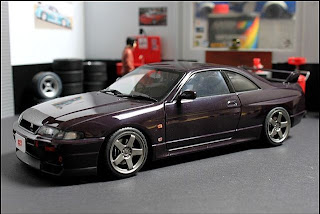Friday, 15 June 2012
Friday, 8 June 2012
Friday, 1 June 2012
Some Supras just do it right...Mark IV (1992–2002)...
The Mark IV Supra's twin turbos operated in sequential mode as opposed to parallel mode. Initially all of the exhaust is routed to the first turbine for reduced lag. This resulted in boost and enhanced torque as early as 1800 rpm, where it already had 300 lb·ft (410 N·m) of torque. Approaching 3500 rpm, some of the exhaust is routed to the second turbine for a "pre-boost" mode, although none of the compressor output is used by the engine at this point. Approaching 4000 rpm, the second turbo's output is used to augment the first turbo's output. As opposed to the parallel mode, the sequential turbos provides quicker low RPM response and increased high RPM boost. (The Mazda RX-7 Twin Turbo also uses a sequential turbo setup, while the Nissan Skyline GT-R, 300ZX Twin Turbo and the Mitsubishi VR4 Legnum and later model Galant used a parallel setup.) This high RPM boost was also aided with technology originally present in the 7M-GE's in the form of the Acoustic Control Induction System (ACIS) which is a way of managing the air compression pulses within the intake piping as to increase power.
For this generation, the Supra received a new 6-speed Getrag/Toyota V160 gearbox on the turbo models while the naturally aspirated models made do with a 5-speed manual W58, revised from the previous version. Each model was offered with a 4-speed automatic with manual shifting mode. Turbo models were equipped with larger brakes and tires than naturally aspirated models. All vehicles were equipped with 5-spoke aluminium alloy wheels and a space saver spare tire on a steel wheel to save weight and space. Additionally, there are other differences such as the differential, headlight assemblies, throttle body, oil cooler.
Toyota took measures to reduce the weight of the current model compared to the previous model. Aluminium was used for the hood, targa top (if so equipped), front crossmember, oil and transmission pans, and the suspension upper A-arms. Other measures included hollow carpet fibers, magnesium-alloy steering wheel, plastic gas tank and lid, gas injected rear spoiler, and a single pipe exhaust. Despite having more features such as dual airbags, traction control, larger brakes, wheels, tires, and an additional turbo, the car was at least 200 lb (91 kg) lighter than its predecessor. The base model with a manual transmission had a curb weight of 3,210 lb (1,460 kg). The Sport Roof added 40 lb (18 kg) while the automatic transmission added 55 lb (25 kg). It had a 51:49 (front:rear) weight distribution. The turbo model came in as 3,450 lb (1,560 kg) with the manual and the automatic added another 10 lb (4.5 kg). Weight distribution was 53% front/47% rear. On a side by side testing in Motor Trend's July 1993 issue, the Supra was heavier than the spartan Mazda RX-7, and aluminium-bodied Honda NSX, but weighed less than the Nissan 300ZX Twin Turbo and the AWD Mitsubishi 3000GT VR4.
For the 1996 model year in the U.S., the turbo model was only available with the automatic transmission due to OBD-II certification requirements. The targa roof was also made standard on all turbo models. For 1997, the manual transmission returned for the optional engine along with a redesign of the tail lights, headlights, front fascia, chromed wheels, and other minor changes such as the radio and steering wheel designs. All 1997 models included badges that said "Limited Edition 15th Anniversary". All turbo models came standard with the rear spoiler. Only minor updating was done for 1998. Along with a 3-spoke steering wheel and redesigned radio. The naturally aspirated engine was enhanced with VVT-i which raised the output by 5 hp (4 kW; 5 PS) and 10 ft·lbf (14 N·m) of torque. In Japan, the turbo engines were installed with VVT-i. The SZ-R model was also updated with the introduction of a six-speed Getrag V161 transmission, the same used for the twin-turbo RZ models.
The stock Mark IV Supra chassis has also proven an effective platform for roadracing, with several top 20 and top 10 One Lap Of America finishes in the SSGT1 class. Despite its curb weight, in 1994 the Mark IV managed a remarkable skidpad rating of 0.95 lateral g's (200 ft) or 0.98 lateral g's. (300 ft) The Mark IV Supra also featured a four-sensor four-channel track tuned ABS system with yaw control whereby each caliper is sensored and the brakes are controlled individually according to the speed, angle, and pitch of the approaching corner. This unique Formula One-inspired braking system allowed the Supra Turbo to record a 70 mph (113 km/h) -0 braking distance of 149 ft (45 m) the best braking performance of any production car tested in 1997 by Car and Driver magazine. This record was finally broken in 2004 by a PorscheCarrera GT, which does it in 145 ft (44 m) .
The US and UK market Supra featured bigger injectors, steel turbines and bigger inlet cam and had emissions in the range of 259 g/km CO2 despite the addition of Exhaust Gas Recirculation (EGR). The Japanese market Supra had CO2 emissions in the range of 224 g/km.
Subscribe to:
Comments (Atom)



























































